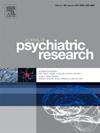缓解期的脑网络交流:双相和单相抑郁症的比较研究
IF 3.7
2区 医学
Q1 PSYCHIATRY
引用次数: 0
摘要
在缓解期区分单相抑郁症(UD)和双相情感障碍(BD)是一项重大的临床挑战。为了减少抑郁发作的潜在混杂效应,我们的研究比较了单相抑郁症和双相情感障碍缓解期患者的白质网络,旨在探索这两种情感障碍之间的区别。我们的队列包括69名缓解期UD患者、55名缓解期BD患者和78名健康对照组(HC)。我们采用弥散张量成像(DTI)来评估白质(WM)网络。此外,我们还使用了一套全面的连接组和五个通信模型来描述全脑 WM 网络内的改变。与HC相比,UD和BD患者的额眶区连接性都有所降低,其中BD患者的降低更为明显。与UD相比,BD患者的导航能力更强,关键脑区连接的最短路径度量值更高。相反,UD 患者在某些脑区的扩散效率更高。可交流性和搜索信息分析显示了两组患者之间不同的连接模式,这对情绪调节和信息处理具有潜在的影响。我们的研究结果突显了BD和UD患者在缓解期不同的大脑连接模式,表明这些模式可以作为区分这两种疾病的神经影像生物标记物。这项研究深入揭示了情绪障碍对大脑连通性的持久影响,对诊断和治疗具有潜在的临床意义。本文章由计算机程序翻译,如有差异,请以英文原文为准。
Brain network communication in remission: a comparative study of bipolar and unipolar depression
Distinguishing between unipolar depression (UD) and bipolar disorder (BD) during periods of remission presents a significant clinical challenge. To mitigate the potential confounding effects of depressive episodes, our study compares the white matter networks of individuals with UD and BD in remission, aiming to explore the differentiation between these two affective disorders. Our cohort included 69 individuals with remitted UD, 55 with remitted BD, and 78 healthy controls (HC). We employed diffusion tensor imaging (DTI) to assess the white matter (WM) network. Additionally, we utilized a comprehensive set of connectome and five communication models to characterize the alterations within the whole-brain WM network. Compared to HC, both UD and BD patients showed reduced connectivity in the frontal orbital region, with BD patients exhibiting a more pronounced decrease. BD patients demonstrated superior navigation ability and higher shortest path metric values in key brain region connections compared to UD. Conversely, UD patients showed greater diffusion efficiency in certain brain regions. Communicability and search information analyses revealed distinct patterns of connectivity between the two patient groups, with potential implications for emotion regulation and information processing. Our findings highlight distinct brain connectivity patterns in BD and UD during remission, suggesting that these patterns could serve as neuroimaging biomarkers for differentiating between the two disorders. The study provides insights into the enduring effects of mood disorders on brain connectivity and has potential clinical implications for diagnosis and treatment.
求助全文
通过发布文献求助,成功后即可免费获取论文全文。
去求助
来源期刊

Journal of psychiatric research
医学-精神病学
CiteScore
7.30
自引率
2.10%
发文量
622
审稿时长
130 days
期刊介绍:
Founded in 1961 to report on the latest work in psychiatry and cognate disciplines, the Journal of Psychiatric Research is dedicated to innovative and timely studies of four important areas of research:
(1) clinical studies of all disciplines relating to psychiatric illness, as well as normal human behaviour, including biochemical, physiological, genetic, environmental, social, psychological and epidemiological factors;
(2) basic studies pertaining to psychiatry in such fields as neuropsychopharmacology, neuroendocrinology, electrophysiology, genetics, experimental psychology and epidemiology;
(3) the growing application of clinical laboratory techniques in psychiatry, including imagery and spectroscopy of the brain, molecular biology and computer sciences;
 求助内容:
求助内容: 应助结果提醒方式:
应助结果提醒方式:


